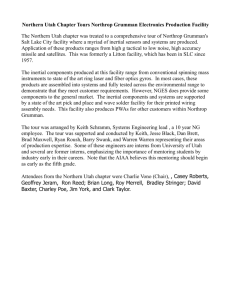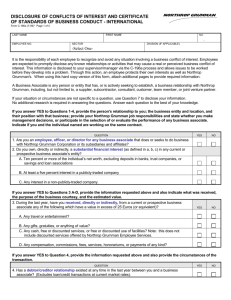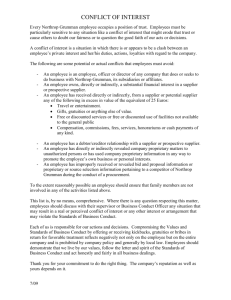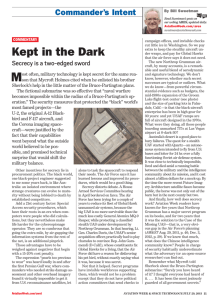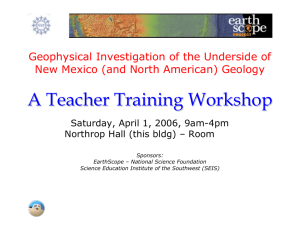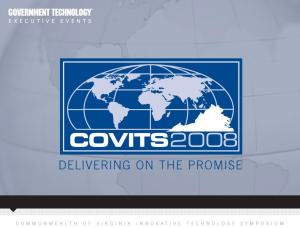Control of 3D Measurements
advertisement
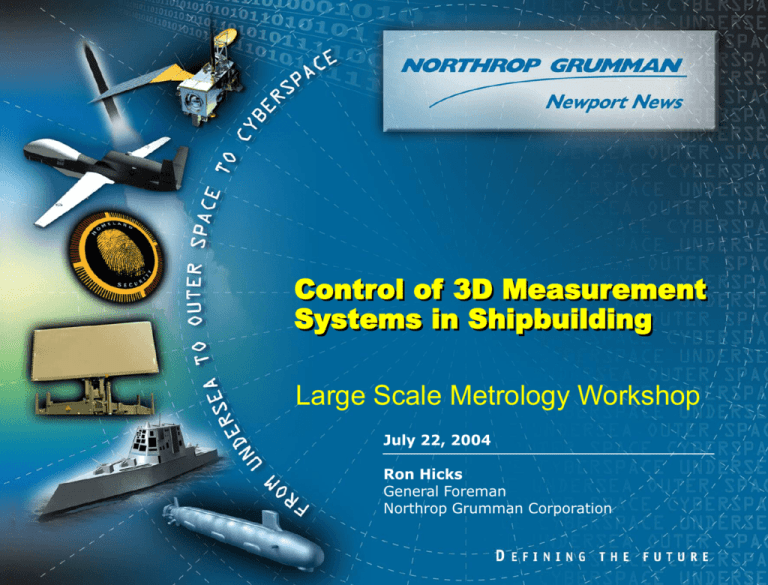
0 Copyright 2004 Northrop Grumman Corporation Control of 3D Measurement Systems in Shipbuilding Large Scale Metrology Workshop July 22, 2004 Ron Hicks General Foreman Northrop Grumman Corporation 1 Copyright 2004 Northrop Grumman Corporation Presentation Outline • Newport News at a Glance • Current Projects • Measurement Equipment • Policies and Procedures • Measurement Uncertainty • Conclusion 2 Copyright 2004 Northrop Grumman Corporation Newport News at a Glance • • • • • Largest Private US Shipyard $2.8 B in Revenues 18,050 Employees Delivered Over 800 Ships — 28 Aircraft Carriers — 53 Nuclear Submarines Strategically Located across from Largest US Navy Base • • 550 Acres of Manufacturing and Construction Facilities — 2 Miles of Waterfront Property — 7 Dry Docks and 1 Floating Dock — 2 Outfitting Berths and 4 Outfitting Piers Over 4,000 Engineers, Designers, and Technicians 3 Copyright 2004 Northrop Grumman Corporation Our Products Virginia Class Submarines Nimitz Class Aircraft Carriers 4 Copyright 2004 Northrop Grumman Corporation Construction 5 Copyright 2004 Northrop Grumman Corporation 3D Systems Employed at Newport News • Laser Trackers • Total Stations • Digital Photogrammetry • Portable CMM’s 6 Copyright 2004 Northrop Grumman Corporation 3D Systems Employed at Newport News • Laser Trackers • Total Stations • Digital Photogrammetry • Portable CMM’s 7 Copyright 2004 Northrop Grumman Corporation Departmental Statistics • 180 surveys per month (average) • 30 man-hours per survey (average) • 83 supervisory, engineering, technical and support personnel. • Work is generally classified as product compliance, process control, alignment or reverse engineering. • Typical tolerances range from ±0.002” - ±0.075”. 8 Copyright 2004 Northrop Grumman Corporation Procedures and Qualifications • Newport News uses an internal procedure (Q-1022) for control of Inspection, Measuring and Test Equipment (IM&TE) • This procedure satisfies the requirements of: — ANSI/ISO/ASQ Q9001-2000 — MIL-STD-45662A — MIL-I-45208A Contractual requirements — MIL-Q-9858A • Working to obtain compliance to ANSI/NCSL Z540-1-1994 • ISO 9000 certified quality system • Licensed by the Department of Energy (DOE) for Navy Nuclear Work 9 Copyright 2004 Northrop Grumman Corporation Calibration Standards • Newport News Procedure Q-1022 requires that all 3D Measurement IM&TE be calibrated and maintain a minimum of a 4:1 accuracy ratio, traceable to the NIST. • Vendor calibrations must adhere to the same 4:1 ratio. • Uncertainty calculations are used to justify calibration ratios less than 4:1. • All 3D Measurement Equipment must display the appropriate labels and tags that indicate their current calibration status. 10 Copyright 2004 Northrop Grumman Corporation System Calibration • Laser trackers, theodolites, total stations, and portable CMM arms are calibrated by the manufacturer according to their recommendations. • Digital photogrammetry is a self-calibrating measurement system. Cameras are periodically returned to the manufacturer for maintenance, cleaning and calibration. • Calibration frequencies are determined by the department, but typically follow the manufacturers recommendations. 11 Copyright 2004 Northrop Grumman Corporation System Operational and Cross Checks • Each system has its own unique operational checks. • Systems are frequently compared to measurements made from other higher or comparable accuracy systems. • Test ranges are frequently measured and measurement uncertainty is calculated. • Reality checks are frequently made to machined parts. • Accuracy and scale are checked to calibrated invar and steel reference bars. These are traceable to NIST. 12 Copyright 2004 Northrop Grumman Corporation Uncertainty in Measurements • Each survey requires — Understanding the capabilities of each system and the job requirements. — Simulation of jobs with high accuracy requirements. — Actual uncertainty calculations. — Reference to known values (scale or reference bars, monuments, ship lines system) • 95.46% confidence interval (± 2 Sigma) for minimum measurement accuracy compared to the product tolerance. 13 Copyright 2004 Northrop Grumman Corporation Uncertainty Calculations • Uncertainty or standard error is calculated with each job. • Calculations must accommodate multiple instrument types. • Higher accuracy jobs are simulated in advance. • Must calculate uncertainties to comply with current procedures. • Requires specialized software to calculate uncertainties from multiple instrument types and stations. 14 Copyright 2004 Northrop Grumman Corporation Unified Spatial Metrology Network (USMN) Laser Tracker Network 15 Copyright 2004 Northrop Grumman Corporation Unified Spatial Metrology Network (USMN) 16 Copyright 2004 Northrop Grumman Corporation Unified Spatial Metrology Network (USMN) Uncertainty Calculated for the Survey Network 17 Copyright 2004 Northrop Grumman Corporation Unified Spatial Metrology Network (USMN) Uncertainty Calculated for the Survey Network 18 Copyright 2004 Northrop Grumman Corporation Uncertainty Characterization Method Laser Tracker Network Field Uncertainty Checks Manufactures Values Horizontal Angle (arc seconds) 0.8 0.5 Vertical Angle (arc seconds) 0.8 0.5 Distance (inches) 0.0003 0.0015 at 30’ *Values are at 1 sigma Uncertainty Magnitude: Average = 0.00162” Scale Bar Delta = 0.0004” (34” scale bar) 19 Copyright 2004 Northrop Grumman Corporation Conclusion • Calculations for uncertainty must be made and reported for each survey to insure performance. • If the uncertainty is known for the actual job conditions, adjustments can be made to meet the overall accuracy requirements. — Multiple measurements — Multiple instrument stations — Guardbanding techniques 20 Copyright 2004 Northrop Grumman Corporation Questions
